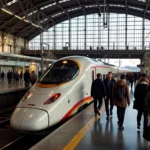A “greenfield airport” might sound like an environmentally friendly airport, but it actually refers to something quite different. In essence, a greenfield airport is a brand new airport built from the ground up on a previously undeveloped site. This “green field” represents a blank canvas for airport planners and architects, free from the constraints of existing infrastructure.
What Makes an Airport a Greenfield Airport?
The defining characteristic of a greenfield airport is its location. Instead of renovating or expanding an existing airport, a greenfield project starts fresh on an undeveloped piece of land. This allows for several key advantages:
- Design Freedom: With no pre-existing runways, terminals, or taxiways to work around, planners have complete control over the airport’s layout and design. This enables the implementation of the latest technologies and innovations in airport design, optimizing efficiency and passenger flow.
- Capacity and Expansion: Greenfield airports can be designed from the outset to accommodate large volumes of passengers and cargo. This is particularly important in rapidly growing regions where existing airport infrastructure is struggling to keep up with demand.
- Strategic Location: By choosing a new location, greenfield airports can be strategically placed to better serve specific geographic areas or target markets, potentially stimulating economic development in the surrounding region.
Advantages and Disadvantages of Greenfield Airports
Like any major infrastructure project, greenfield airports come with their own set of pros and cons:
Advantages:
- Increased Capacity: Greenfield airports offer a solution to airport congestion, allowing for increased flight operations and passenger capacity.
- Economic Growth: The construction and operation of a new airport can be a significant economic driver, creating jobs and attracting businesses to the area.
- Improved Connectivity: Strategically located greenfield airports can enhance regional and international connectivity, boosting tourism and trade.
- Modern Facilities and Technology: Starting from scratch allows for the integration of the latest airport technology, improving efficiency, security, and passenger experience.
Disadvantages:
- High Initial Costs: Developing a greenfield airport is a massive undertaking, requiring substantial investment in land acquisition, construction, and infrastructure.
- Environmental Impact: The construction of a large airport can have significant environmental impacts, requiring careful planning and mitigation strategies.
- Displacement of Communities: Building a new airport may necessitate the relocation of residents or businesses, potentially leading to social and economic disruption.
- Accessibility Challenges: New airports may be located further from existing population centers, potentially creating transportation challenges for passengers.
Examples of Greenfield Airports Around the World
Several notable greenfield airport projects have been developed in recent years, demonstrating the global trend towards these ambitious undertakings.
- Kansai International Airport (KIX), Japan: Built on an artificial island in Osaka Bay, KIX showcases innovative engineering and design, offering a glimpse into the future of airport construction.
- Dubai World Central – Al Maktoum International Airport (DWC), UAE: Designed to be one of the world’s largest airports upon completion, DWC exemplifies the ambitious scale and capacity of greenfield projects.
- Istanbul Airport (IST), Turkey: Replacing Istanbul’s Atatürk Airport, IST is a prime example of a greenfield airport designed to handle massive passenger traffic and solidify the city’s position as a global aviation hub.
The Future of Greenfield Airports
As air travel demand continues to grow, particularly in emerging markets, greenfield airport development is likely to remain an important trend in the aviation industry. These projects offer a way to address capacity limitations, modernize infrastructure, and support economic growth.
However, it is crucial that greenfield airport projects are approached with sustainability, community engagement, and long-term planning in mind. By carefully considering the environmental, social, and economic impacts, greenfield airports can become catalysts for positive change while connecting people and places in an increasingly interconnected world.
FAQs about Greenfield Airports
1. Are greenfield airports more environmentally friendly?
While the term “greenfield” might suggest environmental friendliness, it simply refers to the undeveloped nature of the land. However, many new airports incorporate sustainable design elements and practices to minimize their environmental footprint.
2. Why are greenfield airports often built far from city centers?
Greenfield airports often require large tracts of land, which are more readily available in less densely populated areas. Additionally, locating airports further from city centers can mitigate noise pollution and safety concerns.
3. What are the economic benefits of building a greenfield airport?
Greenfield airport projects can generate significant economic activity through job creation, increased tourism, and the attraction of new businesses to the region.
4. What are some of the challenges in financing greenfield airport projects?
The substantial upfront costs of greenfield airports can be a major hurdle. Financing models often involve a combination of public and private investment, requiring careful planning and risk assessment.
5. How long does it typically take to build a greenfield airport?
The timeline for a greenfield airport project can vary significantly depending on its scale and complexity, but it’s not uncommon for these projects to take several years or even over a decade from conception to completion.
For more information on specific greenfield airport projects, you can explore our articles on the meaning of greenfield airport and the dholera airport project.
Do you have any other questions about greenfield airports or other aviation topics? Our team of experts at AirPort BBI is always ready to provide you with accurate and insightful information. Contact us at +13089626264, email us at [email protected], or visit our office at 404 Bothwell St, Oxford, NE 68967, USA. We are available 24/7 to assist you.
